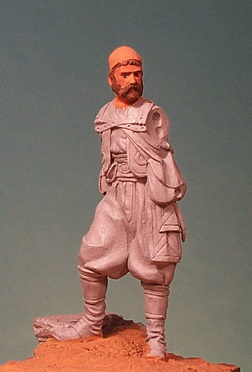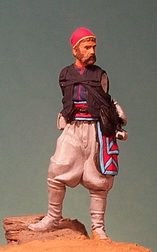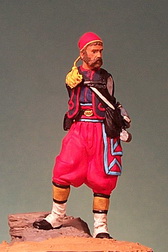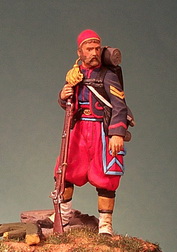HISTORICAL MINIATURES JOURNAL ISSUE NUMBER 17
PUBLISHED
BY GEORGE GRASSE
AMERICAN CIVIL WAR ZOUAVES
RESEARCH NOTES FOR MODELING
54mm SCALE AMERICAN CIVIL WAR ZOUAVES: PART 17
5th NEW YORK INFANTRY REGIMENT
"DURYEA'S ZOUAVES"
Chronological Summary of
Service for the 5th New York Infantry Regiment "Duryea's Zouaves"
|
From / To |
Brigade |
Division |
Corps |
Army |
|
May 1861 - Jul 1861 |
Pierce's Brigade, Newport News,
Department of Virginia |
|
Jul 1861-
Mar 1862 |
Dix's Division,
Baltimore, Maryland |
|
Mar
-
May 1862 |
unknown |
Sykes |
Reserve |
Army of the Potomac |
|
May 1862 -
May 1863 |
3rd |
2nd
(Sykes) |
5th |
Army of the Potomac |
| May
1863 |
Mustered out and unexpired enlistees re-assigned to the 146th New York
Infantry Regiment |
SERVICE RECORD SUMMARY
There were four regiments numbered '5' in the State of New York's
military structure at one time or another during the course of the Civil War.
The first New York regiment to respond to Lincoln's call for 75,000 troops was
the 5th Regiment Infantry (3 Months). It was mustered in on 19 April 1861
and mustered out on 7 August 1861. During the 1863 Gettysburg Campaign,
the 5th Regiment National Guard Infantry (1 month) entered U. S. service for thirty days
in June 1863 and was mustered out on 22 July 1863. Veterans of several New
York regiments whose terms of enlistment expired in late 1863 were organized as the 5th
Regiment Veteran Infantry Regiment (3 years) on 14 October 1863. Veterans and recruits came from
the 5th, 12th, 31st, 37th, and, later, the 94th New York Infantry Regiments.
The regiment was assigned to the 5th Army Corps, Army of the Potomac.
The fourth 5th New York Infantry Regiment (2 years) was named "Duryea's Zouaves"
after its commander,
Colonel Abram Duryea (or Duryée) who was elected by
the regiment's members. The regiment left the state on 23 May 1861 and
arrived at Fort Monroe on 25 May 1861 assigned to Pierce's Brigade of the
Department of Virginia. Its first action was Big Bethel, 10 June 1861, a
baptism of fire in which Union losses were 18 killed, 53 wounded, and 5 missing
for total casualties of 76 men (the regiment's share of losses is not known).
The regiment moved to Baltimore, Maryland, serving there until 11 April 1862, at
which time it was assigned to Sykes' Division of the Army of the Potomac and
moved to the Peninsula taking part in the Siege of Yorktown. That affair
lasted until 4 May 1862.
After a period of rest, the Army of the Potomac under General McClellan began
maneuvers that initiated the Seven Days campaign. The 5th New York
participated in reconnaissance in and around Hanover Court House from 26 to 29
May. Most of June was occupied with more maneuvering in McClellan's drive
to Richmond. The first of the Seven Days battles was fought on 26 June
1862 at Mechanicsville. The next day, 27 June 1862, was fought the battle
of Gaines Mill. In an unusual memoriam to a Union regiment, Dyer (the
author of the compendium from which this chronology is constructed), noted the
following comment, "At Gaines Mill, under Lieut.-Colonel Hiram Duryea, it faced
a musketry fire which cut down one-third of its men and won praises from all who
witnessed its remarkable efficiency and drill while in the thickest of that
fight. It was in that battle that after having received several deadly
volleys it paused at one time, while still under fire, to count off anew so that
its movements might not be deranged by the absence of the fallen men."
The battles continued. On 30 June, was fought White Oak Swamp and
Turkey Bend. All of these engagements were desperate affairs for both the
Union and Confederacy. McClellan was in the midst of changing his base of
operations to Harrison's Landing and was now fighting a determined Confederate
army under the new leadership of General R. E. Lee. On 1 July, Lee
attempted to storm a portion of the Union line at Malvern Hill but massed Union
artillery prevented a breakthrough and McClellan was able to re-establish his
base of operations at Harrison's Landing. The 5th New York with its
depleted numbers remained on duty at that base until 15 August when it was moved
to Fort Monroe and then moved inland to Centerville.
The 5th New York was brigaded with the 10th New York "National Guard Zouaves"
commanded by Colonel Gouverneur K. Warren. As part of the 5th Army Corps
under General Fitz-John Porter, the brigade marched in support of General John
Pope's ill-fated Army of Virginia in the 2nd Bull Run campaign of August 1862.
Both Porter and Pope would become the scapegoats for the surprise ending of the
2nd Battle of Bull Run. Warren's "Zouave" brigade 102 killed and 199
wounded or missing in this engagement.
On the heels of the 2nd Bull Run battle, Lee marched north in a surprise move
that would be called the first invasion of the north. Pope's divisions
were broken up and re-assigned to the Army of the Potomac still under McClellan.
They marched north in pursuit of Lee all the while screening Washington D.C.
The chance of a lifetime for the North came at the Battle of Antietam but
McClellan attacked in several disparate columns never quite coordinated as
Napoleon would have done. The 5th Army Corps and the 5th New York sat out
the battle probably as McClellan's force to cover a retreat if things went
badly. McClellan out-numbered Lee in all arms by a substantial number but,
unlike Napoleon, he could not bring a critical mass against Lee's defenses at
the right place and time.
At the battle of Fredericksburg, 12-15 December 1862, the 5th New York was
still with now-Brigadier General G. K. Warren's Third Brigade, 2nd Division, 5th
Army Corps, now under Brigadier General Dan Butterfield. Warren's brigade
now contained the 140th and 146th New York Regiments, the 10th New York having
been transferred out to the 2nd Army Corps. However, as at Antietam, the
brigade did nothing having six men reported wounded and thirty missing.
The "Mud March" from 20 to 24 January 1863 was endured.
The new commander of the Army of the Potomac, General Hooker, prepared for a
Spring campaign that would end at the Battle of Chancellorsville in early May
1863. Once again, the Third Brigade, now under Colonel Patrick O'Rourke,
did nothing of significance but lost 71 men. A little over a week later,
14 May 1863, the 5th New York "Duryea's Zouaves" were mustered out of Federal
service but recruits were re-assigned to the 146th New York "Garrard's Tigers". The regiment lost
during its two year service 6 officers and 171
enlisted men killed and mortally wounded and 34 enlisted men by
disease for a total loss of 211 men.
Interestingly, a "Second Duryea's Zouaves" regiment had already been formed
in November 1862. The Third Brigade of Sykes' 2nd Division would be
augmented by the 155th Pennsylvania Infantry Regiment. The three regiments
- 140th and 146th New York and 155th Pennsylvania - would be honored by the
government's authorization for all three regiments to wear distinctive Zouave
uniforms, each of a different set of colors.
THE UNIFORM AND EQUIPMENT OF THE 5th NEW YORK INFANTRY "DURYEA'S
ZOUAVES"
The 5th wore a distinctive privately designed French Zouave-style uniform,
as did so many other Union Zouave regiments. In the late 1850's armed
conflict between the North and South was a possibility and hundreds of militia
units on both sides were augmented by enthused "patriots" and new recruits.
One of the most popular uniform styles in the North were copies of French Army
uniforms especially Zouaves and Chasseurs. This idea enhanced enlistments
and was carried on into the war.
The "Duryea's Zouave" uniform was a model for many other
Union Zouave regiments though colors and trim varied greatly. The short
waist-length jacket was dark blue piped at the edges with cuff chevrons and
trefoils. The false vest worn under the
jacket was dark blue with red piping. The waistband was red piped in light
blue. A prominent and decorative waistband tail fell along the right
thigh. Pants were the typical and generous Zouave style in madder red, a
darker shade. The red fez was
bordered in thin yellow piping all around its base with a yellow tassel.
The lower legs were covered with white canvas gaiters secured at the top with a
pale yellow/brown leather "jambon". Shoes were blackened. NCO
stripes were yellow except for flag bearers and corporals of the color guard who
wore chevrons of gold bordered in red.
All equipment was standard federal issue including black knapsack, gray-brown
blanket rolled and attached to the knapsack top, canteen, black haversack, black
waist belt supporting the cartridge box, cap box, and bayonet scabbard, and, at
some point, issued with the Springfield rifle-musket model 1861.
MAKING
A SOLDIER OF "DURYEA'S ZOUAVES"
| Figure 1
 |
The 5th New York "Duryea's Zouaves" figure is made from
the Andrea kit 54-155. Figure 1 shows the basic casting which
has been primed. Only the face has been painted. The
ground work has been painted with "earth", a large bottle of acrylic
paint into which is poured all manner of earthen shades from time to
time.
Figure 2 on the right shows my technique of painting of figure from
the inside out. I started this step by painting the vest dark
blue with its red trim. Next, I painted the waist sash
including its tails that fall over the right thigh. Colors
used were Vallejo VC0947 Red and VC0844 Deep Sky blue.
|
Figure
2  |
|
Figure 3
 |
Figure 3 at left shows the "accessories" to be
attached later when the main figure is completed.
NCOs in this regiment had yellow rank stripes, not as shown in
Figure 3. The corporal's chevrons were
fact, yellow and the cuff piping was red. These were changed
and shown corrected in Photos 5 and 6 below. Haversack, canteen, ammunition box, are cast with the
figure's main body. The rolled blanket was painted in a mix of
two-thirds Vallejo VC0991 Dark Sea Gray and one-third Vallejo VC0874
Tan Earth giving it an almost "mousy" gray color.
Figure 4 at right shows the
completed main casting. All jacket piping is red. I used
Vallejo VC0947 Vermillion Red highlighted with Vallejo VC0817
Scarlet and Vallejo VC0946 Dark Red mixed with a little Vallejo
VC0814 Burnt Cadmium Red.
|
Figure 4
 |
|
Figure 5
 |
Figure 5 at left shows the
completed figure in front view. Casting details such as the
piping and waist band had good relief and were crisp making them
easy to paint. Parts fit quite well. The groundwork on
the metal base was simply a large rock and a flat surface. I
added a broken section of Historex 54mm wagon wheel shown at the
lower left. The bare ground was covered in Elmer's white
glue over which I sprinkled dashes of finely ground red Virginia
dirt and two shades of static grass. (NOTE the correct yellow
corporal stripes)
Figure 6 on the right shows the
completed figure in rear view. I added a simple white "5" to
the knapsack but a specific identification for this regiment is not
known.
|
Figure 6
 |
--------------------------------------------------------------------------------------------------------------------------------
BIBLIOGRAPHY
Dyer, Frederick H. A Compendium of the War of the
Rebellion, Volume III. New York: Thomas Yoseloff Publisher, 1959 (see pages 1406-07).
Editors of Time-Life Books. Echoes of Glory: Arms and
Equipment of The Union. Alexandria, VA: Time-Life Books, 1991.
McAfee, Michael J. Zouaves - The First and the
Bravest. Gettysburg, PA: Thomas Publications, 1991.
Smith, Robin. American Civil War Zouaves, Osprey Elite Series No.
62. London: Osprey, 1996.
Troiani, Don. Don Troiani's
Regiments & Uniforms of the Civil War, Art by Don
Troiani, text by Earl J. Coates, Michael J. McAfee, and Don Troiani.
Mechanicsburg, PA: Stackpole Books, 2002 (see
page 72-73 for art work and text).
GO TO?
© Copyright by George Grasse





